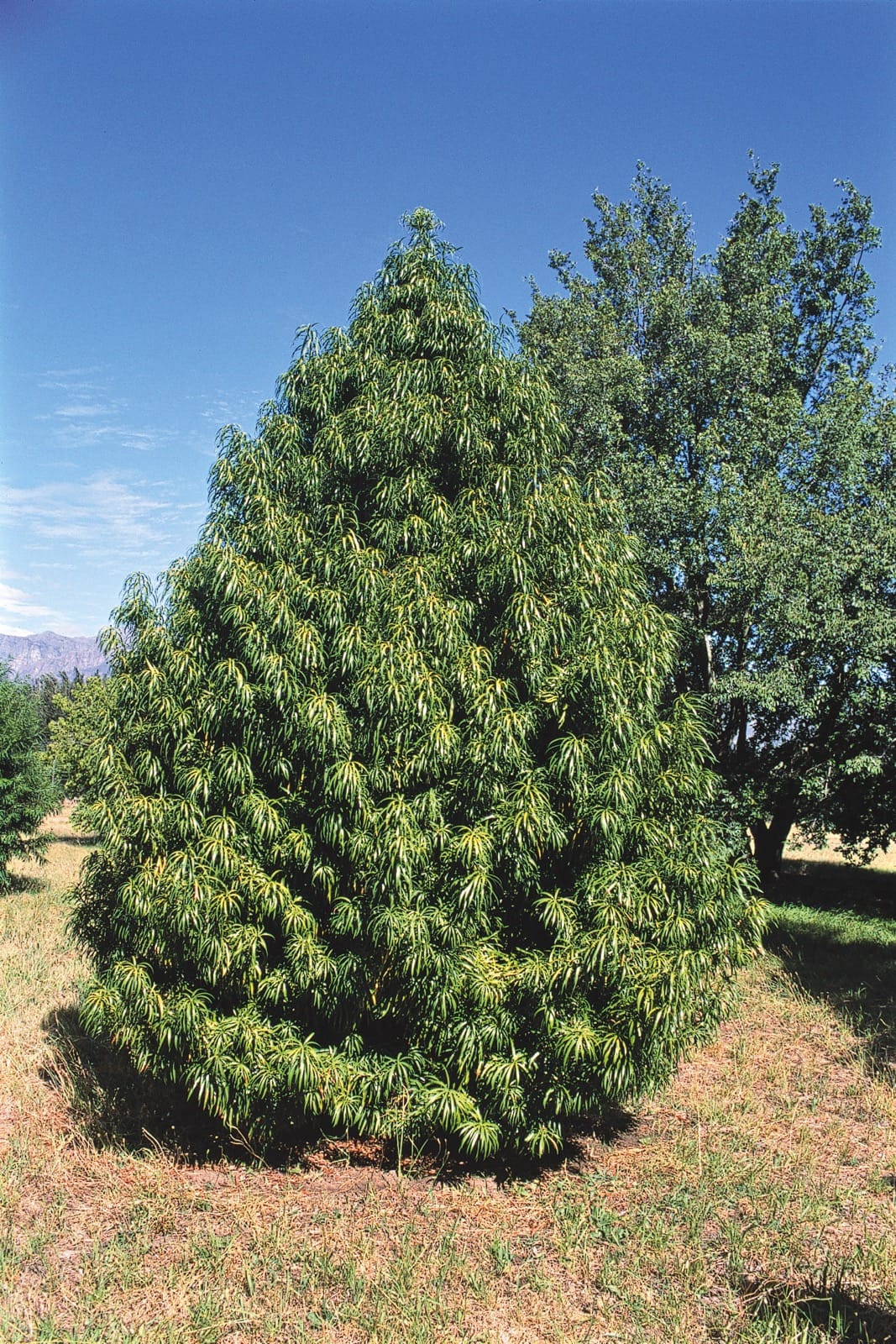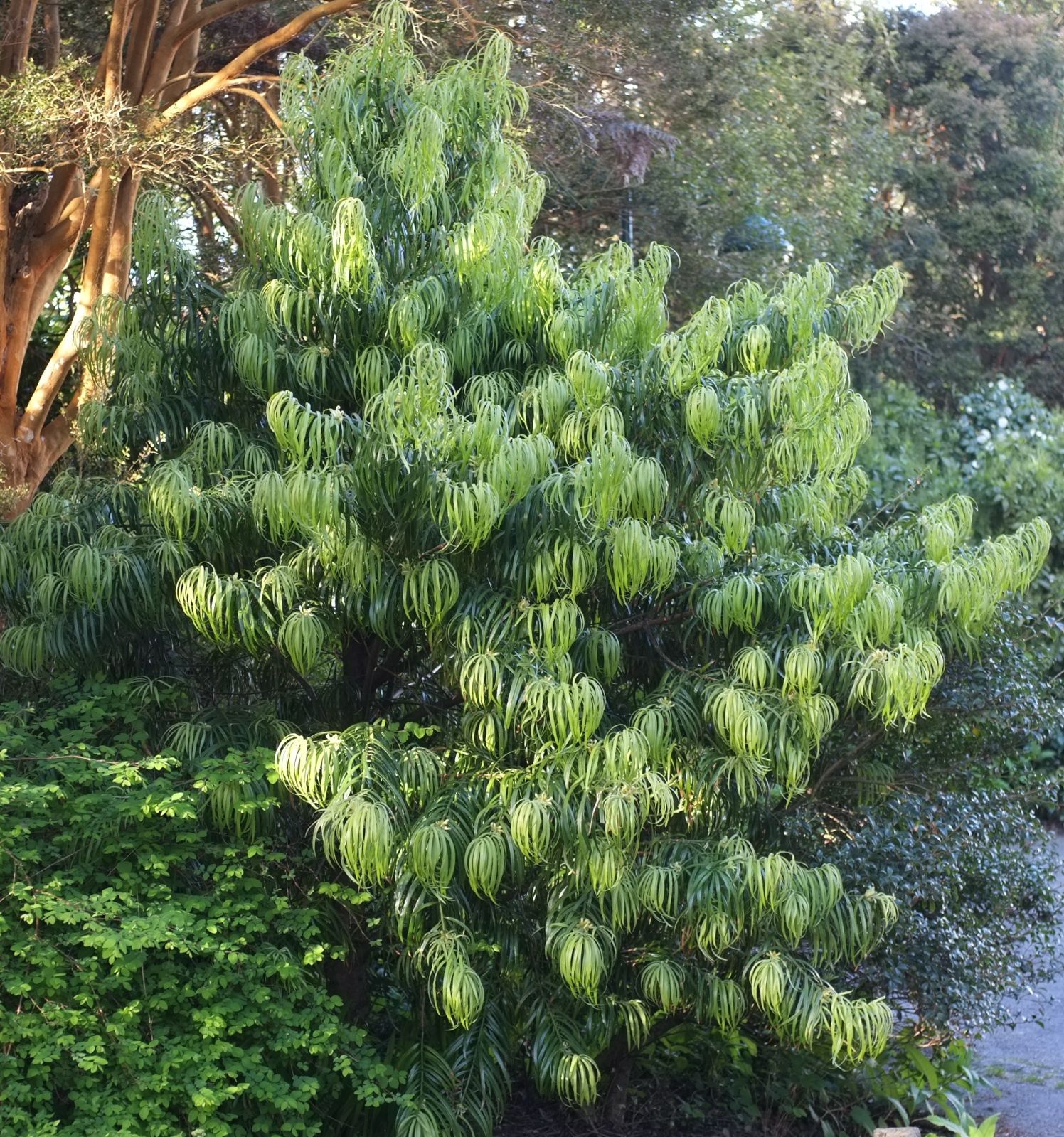Podocarpus henkelii
Sponsor
Kindly sponsored by
The British Conifer Society in memory of Derek Spicer VMM, founder member.
Credits
Tom Christian (2023)
Recommended citation
Christian, T. (2023), 'Podocarpus henkelii' from the website Trees and Shrubs Online (treesandshrubsonline.
Genus
Common Names
- Henkel's Yellowwood
- Long-leaf Yellowwood
Synonyms
- Podocarpus ensiculus Melville
Other taxa in genus
- Podocarpus acutifolius
- Podocarpus acutifolius × lawrencei
- Podocarpus acutifolius × nivalis
- Podocarpus acutifolius × totara
- Podocarpus brassii
- Podocarpus costalis
- Podocarpus drouynianus
- Podocarpus elatus
- Podocarpus elongatus
- Podocarpus guatemalensis
- Podocarpus laetus
- Podocarpus laetus × nivalis
- Podocarpus lambertii
- Podocarpus latifolius
- Podocarpus lawrencei
- Podocarpus lawrencei × nivalis
- Podocarpus macrophyllus
- Podocarpus matudae
- Podocarpus milanjianus
- Podocarpus nakaii
- Podocarpus neriifolius
- Podocarpus nivalis
- Podocarpus nubigenus
- Podocarpus oleifolius
- Podocarpus parlatorei
- Podocarpus pilgeri
- Podocarpus pseudobracteatus
- Podocarpus salignus
- Podocarpus spinulosus
- Podocarpus totara
Tree to 20–35 m. Trunk straight, to 1.8 m dbh, becoming fluted and spirally twisted. Bark thin, fibrous, yellowish grey, brown or dark grey, smooth at first, becoming longitudinally fissured on old wood and peeling to reveal reddish brown underbark. Branches ascending at first, spreading or somewhat pendulous later. Branchlets stout, finely grooved. Terminal buds globose to short-conical, 3–5 mm wide at base, with imbricate inner scales and a few free outer scales with recurved margins and rolled apices. Leaves spreading or drooping to pendulous, (5–)9–17 × 0.5–1 cm, more or less linear and somewhat falcate, tapering to apex and petiolate base, margins weakly revolute or +/- flat; upper surface glossy dark green with weakly defined midrib minutely raised in lower ⅔ of lamina; lower surface dull green with a more distinct midrib with stomatal bands either side. Pollen cones solitary or in clusters of 1–5, cylindrical, 4–5 × 0.4–5.5 cm, pink. Seed cones solitary, on a stout peduncle 5–10 mm long, formed of 2 bracts not or only slightly enlarging to form a small receptacle that remains bluish green. Seed including the epimatium ellipsoid, 1.7–2.2 × 1.4–1.8 cm, green ripening pruinose or purplish, exuding a whitish latex when cut. (Farjon 2017; Grimshaw & Bayton 2009).
Distribution Malawi South Africa Eastern Cape, KwaZulu-Natal Tanzania
Habitat Moist montane evergreen rainforests at 1300–2000 m asl and occasionally in coastal forests.
USDA Hardiness Zone 8b-9
RHS Hardiness Rating H4
Conservation status Endangered (EN)
‘The long, pendulous and shiny leaves make Podocarpus henkelii an extremely attractive evergreen tree, a virtue recognised by its acceptance into mainstream horticulture in southern California and its native South Africa’. So began John Grimshaw’s account of this species in New Trees (Grimshaw & Bayton 2009) and indeed it is hard to improve upon this introduction. The young tree referred to in New Trees growing at Tregrehan continued to dodge frosts thanks to its late-flushing to reach a height of about 5 m, but it then became unstable at the root; judicious pruning saved it and it had recovered to about the same height by summer 2022 (Smith & Hudson 2017; pers. obs. 2022). Another tree had reached 5 m at Carreg Dhu Gardens on the Scilly Isles by 2016; in 2017 there was a 3.5 m tree at Overbeck’s, Devon, and in 2022 a young tree at Kew was 2.5 m (Tree Register 2023). The best of four thriving trees at Glendurgan, Cornwall, was approaching 4 m in early 2023 (T. Cutter pers. comm.). Charles Williams has observed that it is ‘fairly wind hardy’ in Cornwall but can succumb to low temperatures (‘beyond –10°C’) at least in infancy (Williams 2009).
P. henkelii is occasionally offered by specialist UK nurseries but is better established in warmer areas such as the US (especially California) Australia and New Zealand, although accounts of specimens are few. It is certainly worthy of greater experimentation in mild, coastal districts of western and southern Britain, across the island of Ireland, and in sheltered gardens along the French Atlantic coast, but a moist site is preferable: at least at Kew the summer drought of 2022 proved too much, and even well established plants suffered terribly; in early 2023 it remains to be seen whether they will recover (K. Martin pers. comm.).
At one time considered ‘Least Concern’ (Walter & Gillett 1998) subsequent study has revealed P. henkelii to meet the criteria for the ‘Endangered’ category of threat. Principal threats include unsustainable logging and more general habitat degradation and the ‘severely fragmented’ global population (Farjon 2018).
















